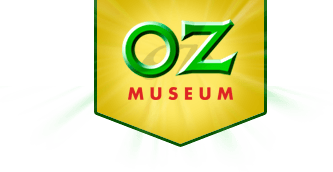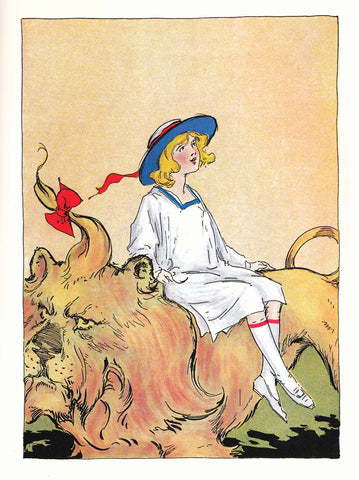 VISIT
MUSEUM STORE
MEMBERSHIP
OZ NEWS
CONTACT
VISIT
MUSEUM STORE
MEMBERSHIP
OZ NEWS
CONTACT
THE ETERNAL & WORLD-WIDE MAGIC OF THE FIRST “AMERICAN FAIRY TALE”
Wamego #81 Mar 17, 2017

[Above left: The Spanish EL MAGO DE OZ was published in Chile in 1940 and told L. Frank Baum’s story as adapted a year earlier for the Metro-Goldwyn-Mayer film. The soft-cover book was illustrated with movie stills. Right: The rear cover of O MAGICO DE OZ, published in Portuguese in Brazil in 1939. This was, as far as we now know, the first published book in any language to follow the MGM plot line. It, too, featured OZ stills but also incorporated eight actual film frame blow-ups to picture Dorothy’s Kansas adventures at the beginning of the tale, as Metro had released no official photographs of those segments.]
Oz devotees, collectors, and researchers are well aware of a very special historical designation accorded THE WONDERFUL WIZARD OF OZ: it is universally acknowledged as the first “American Fairy Tale.” Looking back to 1900, when L. Frank Baum’s book was published, it’s easy to see how such a phrase was coined and endorsed. The most popular fantasy stories for children up to that time were the “Wonderland” and “Looking Glass” adventures of Alice from Englishman Lewis Carroll, and the translated European tales of Hans Christian Andersen and the Brothers Grimm.
Then along came Baum, with his Kansas-based heroine and her dog. Her soon-to-be boon companions were a Scarecrow (a figure familiar to any child in agricultural America), a Tin Woodman (constructed of the same metal used to make the cans on the pantry shelf), and a Lion (who admitted to cowardice, thus enthralling children who might otherwise have been frightened by the king of the beasts). Later in the OZ plot, the potentially terrifying Wizard himself turned out to be the type of carnival balloonist/fakir one saw at many a United States county fair. Finally, even the wicked witches were comparatively easy to dispatch, as long as one had access to a bucket of water or a falling house. (Granted, the latter isn’t especially commonplace or handy, but for the legion of kids who protested bath-time, a major villainess whose terror is water was a relatable and glee-inducing concept!)
All of this is a long preamble to sharing one of the happiest – if now commonly accepted – facts about Baum’s Oz. If rooted firmly here, the magic of the “first American fairy tale” also has long-since spread everywhere else in the world. Copies of Oz books in foreign languages are among the many attractions at The OZ Museum in Wamego, KS, and their mere existence is great, good fun. The diverse, original artwork incorporated in (or used on the cover of) many such volumes makes for absolute delight. So here – just for the colorful joy of it all, and in celebration of the pervasive, far-reaching power of Dorothy & Her Friends – are a few Oz books from abroad! [As a side note: the books shown here are from my personal collection and not that of The OZ Museum.]

It’s now difficult to determine how many different languages have told an Ozzy tale. Apparently, France was the first foreign land to publish Oz translations: they produced THE WIZARD OF OZ and THE LAND OF OZ in, respectively, 1932 and 1933. Above, right, is a subsequent French WIZARD, issued in 1964 as LE MAGICIAN D’OZ. At left is the 1963 Israel Publishing House edition in Hebrew, HUKOSEM MEIERETZ OOZ.

The 1964 German edition of DER ZAUBERER OZ, above right, was published in Berlin, while DE GROTE TOVENAAR VAN OZ (inaccurately credited to Frank L. Baum!) came – in Dutch – from Holland in 1962 and is shown at left.

Additionally, there have been numerous translations of Baum’s other Oz books. The cover of a Japanese edition of THE PATCHWORK GIRL OF OZ, above right, portrays not only such standard Ozians as Dorothy, Toto, and the Scarecrow but augments them with characters original to that title: the Woozy (whose eyes here flash fire, as they do at a pivotal moment in the story), Ojo the Munchkin boy (whose combined curiosity and love for his uncle spur the plotline), the ever-proud Glass Cat (whose brains and heart are ever-visible), and Scraps, the Patchwork Girl herself.
Pictured above left is the front cover of the Brazilian O MAGICO DE OZ; interestingly, it’s a colorized version of promotional ad/poster art created for the MGM movie in 1939 by celebrated caricaturist Al Hirschfeld. The copies of O MAGICO DE OZ and EL MAGO DE OZ (as shown together at the top of this article) were rediscovered in 1988 in the Turner Entertainment Company archives when I was doing research for THE WIZARD OF OZ: THE OFFICIAL 50th ANNIVERSARY PICTORIAL HISTORY (Warner Books, 1989). Turner executives permitted me to borrow the two books to photograph for illustrative use in that title and later – pleased by the success of the PICTORIAL HISTORY – they gifted me with the Portuguese and Spanish translations, which was as gracious and generous a gesture as one could imagine.
Tucked into their file copy of O MAGICO DE OZ was a typewritten memo on MGM stationery. Slugged “New York,” it was dated March 6, 1940, and while the handwritten name of the signee is indecipherable, the note was addressed to Mr. J. M. Weinstein. It begins “Here’s the translation you requested,” and the text that follows is derived from an explanatory three paragraphs in Portuguese, printed in the test at the front of the book. Those passages were prepared by Armando Bertoni as a sort of foreword to the Brazilian volume, and Bertoni seems to have been an avowed Baum fan, who authored both this version of the story as well as an earlier OZ radio play. This is the translation of his words:
“The story contained in these pages represents merely the effort of memory of one who, having read the original work by L. Frank Baum in order to adapt it for the radio theatre, attempted later to define in a little book the really marvelous film version created by Metro-Goldwyn-Mayer.
“Thus we have this work written in language understandable to the juvenile public as a comparison between the original story and that which the cinema modified in part without altering the profound charm and the suave philosophy which it holds.
“It is hoped that Brazilian children will obtain great benefits from this little book.”
I think it’s more than safe (it’s a given!) to say that such benefits did indeed accrue -- as they have for countless billions of children in many countries. Foreign language editions of the Oz stories are now well into their ninth decade of publication, and their magic has both traveled and most happily permeated the world.
-------------- with special thanks to Douglas and David Greene and the late Dick Martin, all of whom were among the very first trailblazers to investigate Oz books from foreign lands for The International Wizard of Oz Club, Inc.
Article by John Fricke



